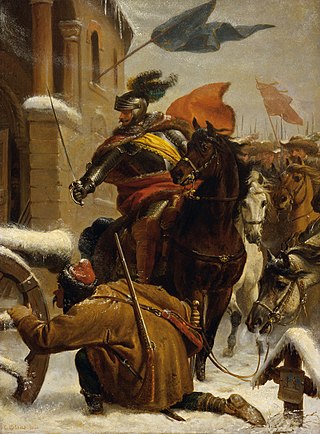
The Battle of Tuttlingen was fought in Tuttlingen on 24 November 1643 between the French army in Germany led by Marshal Josias Rantzau, composed of French soldiers and the so called Weimarans or Bernhardines, German troops once in service of Bernard of Saxe-Weimar. They were defeated by the forces of the Holy Roman Empire, Bavaria and Spain led by Franz von Mercy. Technically, Mercy led a military force composed of his Bavarian army, supported by Imperial, Spanish, and Lorrainer troops. The French army was wiped out in a surprise attack in heavy snowfall along with French strategic gains since 1638. The French court suppressed the defeat and it remains largely unknown today, even among historians of the war.
The Battle of Konzer Brücke was fought as part of the Franco-Dutch War on 11 August 1675 and resulted in an Imperial victory.

The siege of Lille was the salient operation of the 1708 campaign season during the War of the Spanish Succession. After an obstinate defence of 120 days, the French garrison surrendered the city and citadel of Lille, commanded by Marshal Boufflers, to the forces of the Duke of Marlborough and Prince Eugene.
The 1640 siege of Turin was a major action in two distinct wars: the Franco-Spanish War (1635–59) and the Piedmontese Civil War. When Thomas Francis, Prince of Carignano and his Piedmontese faction captured Turin, the French garrison supporting the Regent Christine Marie of France retired within the citadel and continued to resist. A Franco-Piedmontese army led by Henri de Lorraine, count of Harcourt and Henri de la Tour d'Auvergne, Vicomte de Turenne invested the forces under Prince Thomas within the city. Finally, a Spanish army under Diego Felipez de Guzmán, Marquis of Leganés appeared and encircled the French besiegers. In this triple siege, the Spanish army surrounded the French army which surrounded Prince Thomas' Piedmontese who surrounded the French controlled citadel. In the end the French prevailed; Prince Thomas surrendered on terms and was allowed to march his troops elsewhere, leaving Turin in French control. Turin is a major city in the northwest part of modern-day Italy.

The siege of Kehl was one of the opening moves of the French Rhineland campaign in the War of the Polish Succession, at the fortress town of Kehl in the upper Rhine River valley in the Holy Roman Empire. A large French army under the command of the Duke of Berwick besieged and captured the fortress, which was lightly garrisoned and in poor condition.

The siege of Bergen op Zoom took place during the Austrian War of Succession, when a French army, under the command of Count Löwendal and the overall direction of Marshal Maurice de Saxe, laid siege and captured the strategic Dutch border fortress of Bergen op Zoom on the border of Brabant and Zeeland in 1747. The fortress was defended by Dutch, Austrians, British, Hanoverians and Hessians that supported the Pragmatic Sanction.

The Battle of Les Avins or Avein took place on 20 May 1635, outside the town of Les Avins, near Huy in modern Belgium, then part of the Bishopric of Liège. It was the first major engagement of the 1635 to 1659 Franco-Spanish War, a connected conflict of the Thirty Years' War.

The siege of Philippsburg was conducted by French forces against troops of the Holy Roman Empire in the fortress of Philippsburg in the Rhine River valley during the War of the Polish Succession. The Duke of Berwick led 100,000 men up the Rhine Valley, of which 60,000 were detached to invest the fortress at Philippsburg, beginning on 26 May 1734. An Imperial relief army of 70,000 under the aging Prince Eugene of Savoy was unsuccessful in actually relieving the siege. On 12 June Berwick was killed by a cannonball while inspecting the trenches, and command of the besiegers fell to Marshals d'Asfeld and Noailles. The fortress surrendered one month later, and the garrison withdrew to the fortress of Mainz with the honours of war.

The Relief of Thionville took place on 7 June 1639, during the Thirty Years' War.

The siege of Maastricht took place in April–May 1748 during the War of the Austrian Succession. A French force under the overall command of Maurice de Saxe besieged and captured the Dutch barrier fortress of Maastricht in the final few months of the campaign in the Low Countries. After a relatively long siege the garrison of Maastricht capitulated and marched out with the honours of war. Maastricht was returned along with France's conquests in the Austrian Netherlands according to the Treaty of Aix-la-Chapelle signed in 1748.

The first siege of Badajoz was a siege carried out during the Peninsular War on the Spanish town of Badajoz, by the French general Soult.
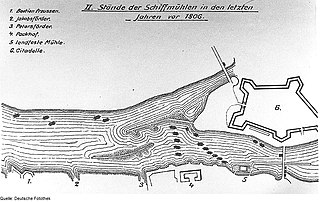
The siege of Magdeburg was a siege of the city that took place from 25 October to 8 November 1806 during the war of the Fourth Coalition. A French force, initially under the command of Marshal Grand Duke of Berg Joachim Murat, then a French army Corps under the command of Marshal Michel Ney laid siege and eventually obtained the surrender of Franz Kasimir von Kleist's Prussian force that had taken refuge in Magdeburg, Prussia's second city.
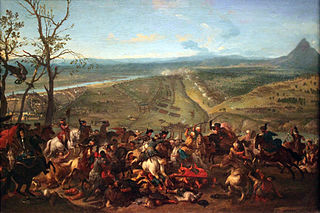
The siege of Belgrade was a successful attempt by Austrian troops under the command of Prince Eugene of Savoy to capture the strategically important city of Belgrade from the Ottoman Empire. It took place during the Seventh Ottoman–Venetian War (1714–1718), barely a year after the Austrian victory at the Battle of Petrovaradin (Peterwardein). The Austrians routed the Ottoman relief army under Grand Vizier Hacı Halil Pasha on 16 August. As a consequence, the Belgrade garrison, deprived of relief, surrendered to the Austrians on 21 August. The Ottoman Sultan Ahmed III sued for peace, resulting in the Treaty of Passarowitz a year later, which completed the transfer of the remainder of Hungary, the Banat and the city of Belgrade into Austrian hands.

In the siege of Tarragona, Catalonia, from 5 May to 29 June 1811, Louis Gabriel Suchet's French Army of Aragon laid siege to a Spanish garrison led by Lieutenant General Juan Senen de Contreras. A British naval squadron commanded by Admiral Edward Codrington harassed the French besiegers with cannon fire and transported large numbers of reinforcements into the city by sea. Nevertheless, Suchet's troops stormed into the defenses and killed or captured almost all the defenders. The action took place at the port of Tarragona, Catalonia, on the east coast of Spain during the Peninsular War, part of the Napoleonic Wars.
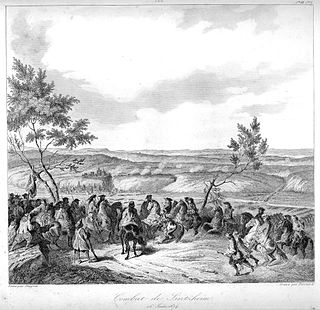
The Battle of Sinsheim took place on 16 June 1674 during the 1672-1678 Franco-Dutch War. An Imperial force commanded by Aeneas de Caprara was marching towards Heidelberg, in order to join their main army under Alexander von Bournonville. It was intercepted just outside Sinsheim by the French commanded by Turenne; the Imperialists repulsed the first two French assaults but were eventually forced to retreat.

The siege of Mequinenza saw a 16,000-man Imperial French corps commanded by Louis Gabriel Suchet invest a 1,000-strong Spanish garrison under Colonel Carbon. Mequinenza and its castle were captured by the French after an operation lasting about three weeks. The action occurred during the Peninsular War, which formed part of the Napoleonic Wars. Mequinenza is located at the confluence of the Ebro and Segre Rivers about 211 kilometres (131 mi) west of Barcelona.
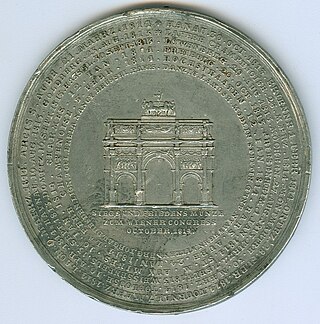
The Battle of Hoogstraten was fought on 11 January 1814 between a French army, led by François Roguet, and a Russo-Prussian-British army, led by Friedrich Wilhelm Freiherr von Bülow. The battle, which ended in a Prussian victory, consisted of a series of engagements situated between Essen and Turnhout. The battle was named after Hoogstraten, the main town of the Kempen region.

The siege of Bouchain, was a siege of the War of the Spanish Succession, and a victory for the French troops of the Duc de Villars. A French army of 20,000 men besieged and captured the Allied-controlled fortifications after an 18-day siege, with the 2,000-strong Dutch-Imperial garrison under Major-General Grovenstein capitulating on 19 October.
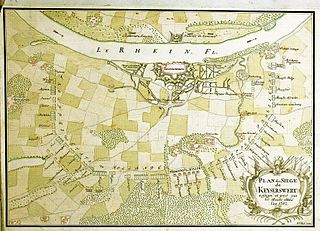
The siege of Kaiserswerth, was a siege of the War of the Spanish Succession. Prussian and Dutch troops numbering 38,000 men and 215 artillery pieces and mortars under the command of Imperial Field Marshal Walrad, Prince of Nassau-Usingen, besieged and captured the small French fortress on the Lower Rhine, which the French had occupied without resistance the previous year. The Dutch regarded the capture of this fortification as more important than an advance into the French-held Spanish Netherlands.

The siege of Philippsburg was a French siege of the Rhine fortress of Philippsburg during the Thirty Years' War. After the battle of Freiburg in early August, the French under the Duc d'Enghien refrained from attacking the city and marched north to besiege Philippsburg instead. The place fell after a two-week siege. The French took Worms, Oppenheim, Mainz and Landau over the following weeks.





















